实验3:OpenFlow协议分析实践
一、实验目的
能够运用 wireshark 对 OpenFlow 协议数据交互过程进行抓包;
能够借助包解析工具,分析与解释 OpenFlow协议的数据包交互过程与机制。
二、实验环境
下载虚拟机软件Oracle VisualBox;
在虚拟机中安装Ubuntu 20.04 Desktop amd64,并完整安装Mininet;
三、实验要求
(一)基本要求
搭建下图所示拓扑,完成相关 IP 配置,并实现主机与主机之间的 IP 通信。用抓包软件获取控制器与交换机之间的通信数据包。

| 主机 | IP地址 |
|---|---|
| h1 | 192.168.0.101/24 |
| h2 | 192.168.0.102/24 |
| h3 | 192.168.0.103/24 |
| h4 | 192.168.0.104/24 |
-
配置ip地址

-
运行wireshark,选择any模式进行抓包,开启另一个终端,命令行运行031902241.py文件,运行pingall


- 查看抓包结果,分析OpenFlow协议中交换机与控制器的消息交互过程(截图以其中一个交换机为例)
-
OFPT_HELLO 源端口6633 -> 目的端口55224,从控制器到交换机

-
OFPT_HELLO 源端口55224-> 目的端口6633,从交换机到控制器,此处协议为openflow1.5
控制器与交换机建立连接,并使用OpenFlow 1.0

-
OFPT_FEATURES_REQUEST 源端口6633 -> 目的端口55224,从控制器到交换机
控制器请求交换器的特征信息
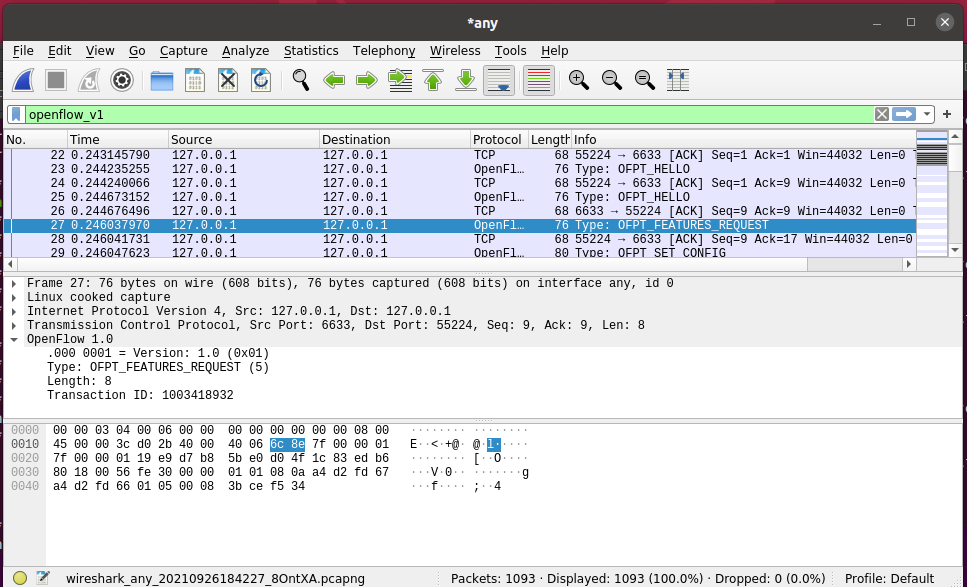
-
OFPT_SET_CONFIG 源端口6633 -> 目的端口55224,从控制器到交换机
控制器要求交换机按照所给出的信息进行配置

-
OFPT_PORT_STATUS 源端口55224-> 目的端口6633,从交换机到控制器
当交换机端口发生变化时,交换机告知控制器相应的端口状态
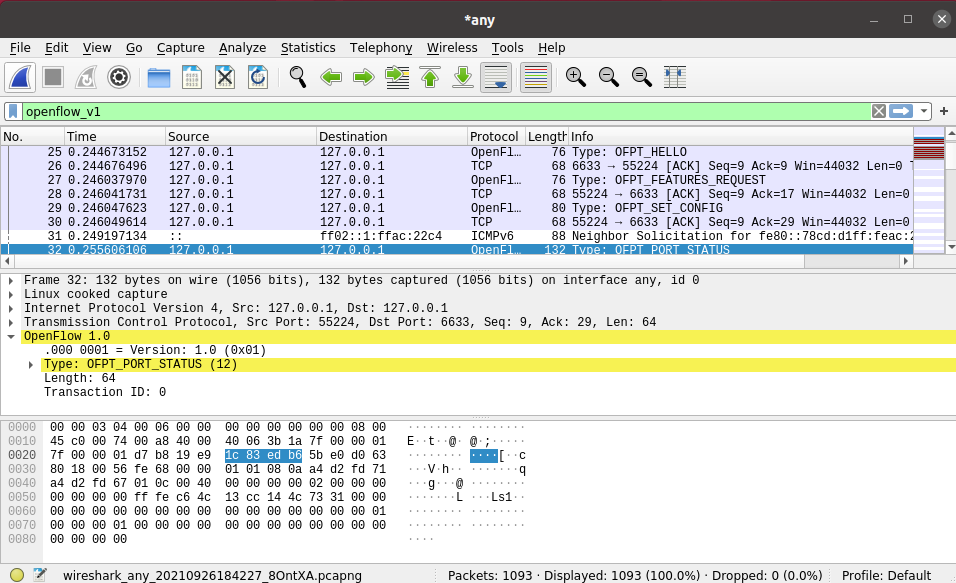
-
OFPT_FEATURES_REPLY 源端口55224-> 目的端口6633,从交换机到控制器
交换机告知控制器它的特征信息

-
OFPT_PACKET_IN 源端口55224-> 目的端口6633,从交换机到控制器
交换机告知控制器有数据包进来,请求控制器指示

-
OFPT_PACKET_OUT 源端口6633 -> 目的端口55224,从控制器到交换机
控制器要求交换机按照所给出的action进行处理

-
OFPT_FLOW_MOD 源端口6633 -> 目的端口55224,从控制器到交换机
控制器对交换机进行流表的添加、删除、变更等操作

-
交互图

-
交换机与控制器建立通信时是使用TCP协议还是UDP协议?
如图所示为(Transmission Control Protocol)TCP协议。

(二)进阶要求
将抓包结果对照OpenFlow源码,了解OpenFlow主要消息类型对应的数据结构定义。相关数据结构可在openflow安装目录openflow/include/openflow当中的openflow.h头文件中查询到
- HELLO
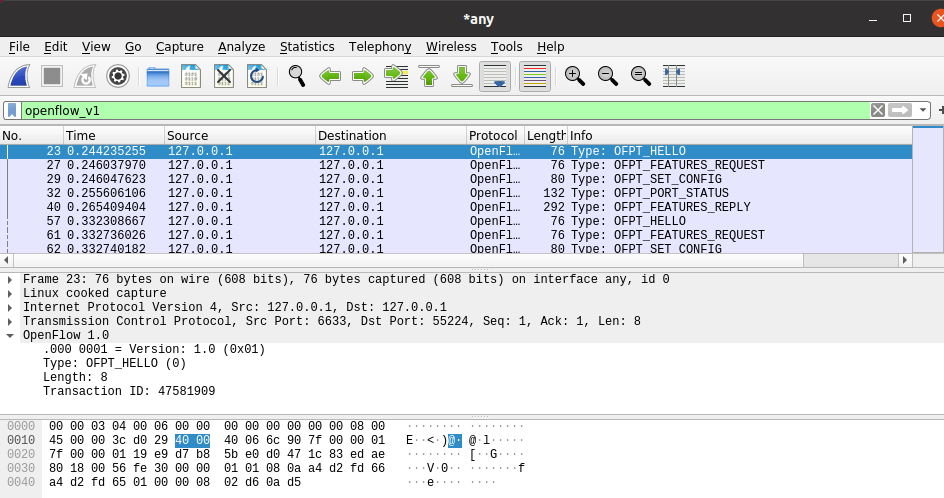
struct ofp_header {
uint8_t version; /* OFP_VERSION. */
uint8_t type; /* One of the OFPT_ constants. */
uint16_t length; /* Length including this ofp_header. */
uint32_t xid; /* Transaction id associated with this packet.
Replies use the same id as was in the request
to facilitate pairing. */
};
struct ofp_hello {
struct ofp_header header;
};
可以看到对应了HELLO报文的四个参数
- FEATURES_REQUEST
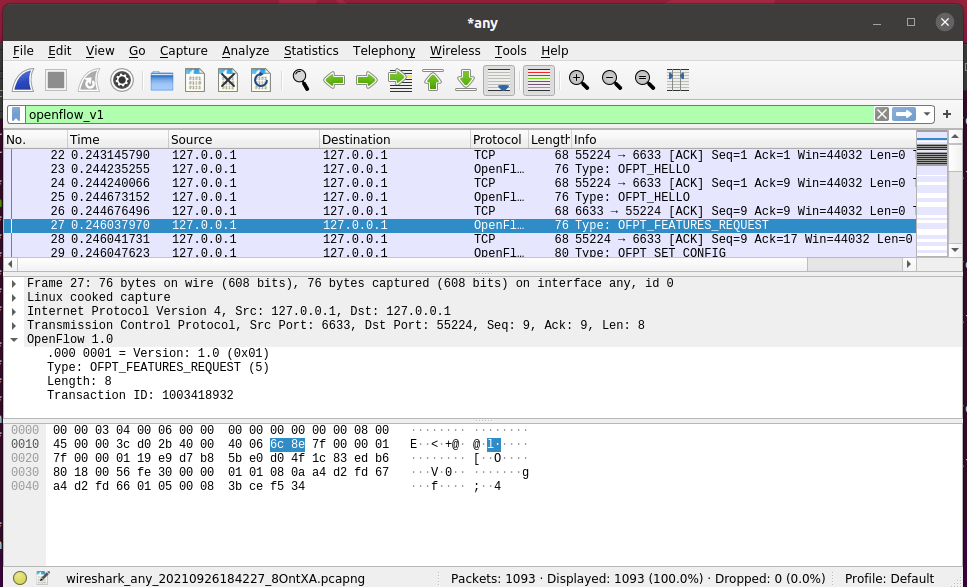
struct ofp_header {
uint8_t version; /* OFP_VERSION. */
uint8_t type; /* One of the OFPT_ constants. */
uint16_t length; /* Length including this ofp_header. */
uint32_t xid; /* Transaction id associated with this packet.
Replies use the same id as was in the request
to facilitate pairing. */
};
-
SET_CONFIG

控制器下发的交换机配置数据结构体
/* Switch configuration. */
struct ofp_switch_config {
struct ofp_header header;
uint16_t flags; /* OFPC_* flags. */
uint16_t miss_send_len; /* Max bytes of new flow that datapath should
send to the controller. */
};
- PORT_STATUS

/* A physical port has changed in the datapath */
struct ofp_port_status {
struct ofp_header header;
uint8_t reason; /* One of OFPPR_*. */
uint8_t pad[7]; /* Align to 64-bits. */
struct ofp_phy_port desc;
};
- FEATURES_REPLY

struct ofp_switch_features {
struct ofp_header header;
uint64_t datapath_id; /* Datapath unique ID. The lower 48-bits are for
a MAC address, while the upper 16-bits are
implementer-defined. */
uint32_t n_buffers; /* Max packets buffered at once. */
uint8_t n_tables; /* Number of tables supported by datapath. */
uint8_t pad[3]; /* Align to 64-bits. */
/* Features. */
uint32_t capabilities; /* Bitmap of support "ofp_capabilities". */
uint32_t actions; /* Bitmap of supported "ofp_action_type"s. */
/* Port info.*/
struct ofp_phy_port ports[0]; /* Port definitions. The number of ports
is inferred from the length field in
the header. */
};
/* Description of a physical port */
struct ofp_phy_port {
uint16_t port_no;
uint8_t hw_addr[OFP_ETH_ALEN];
char name[OFP_MAX_PORT_NAME_LEN]; /* Null-terminated */
uint32_t config; /* Bitmap of OFPPC_* flags. */
uint32_t state; /* Bitmap of OFPPS_* flags. */
/* Bitmaps of OFPPF_* that describe features. All bits zeroed if
* unsupported or unavailable. */
uint32_t curr; /* Current features. */
uint32_t advertised; /* Features being advertised by the port. */
uint32_t supported; /* Features supported by the port. */
uint32_t peer; /* Features advertised by peer. */
};
可以看到与图中信息一一对应,包括交换机物理端口的信息
- PACKET_IN
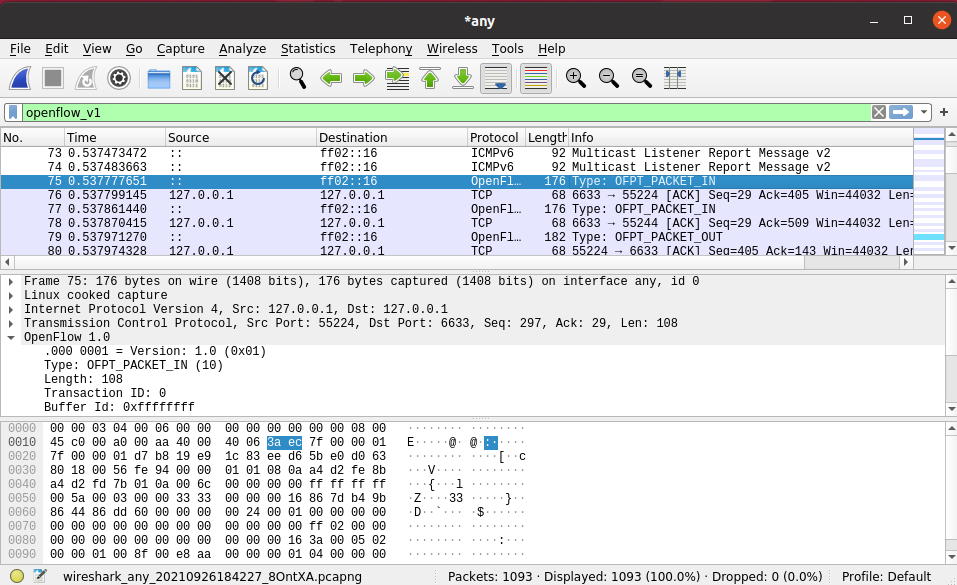
PACKET_IN有两种情况:
交换机查找流表,发现没有匹配条目
enum ofp_packet_in_reason {
OFPR_NO_MATCH, /* No matching flow. */
OFPR_ACTION /* Action explicitly output to controller. */
};
有匹配条目,对应的action是OUTPUT=CONTROLLER,固定收到向控制器发送包
struct ofp_packet_in {
struct ofp_header header;
uint32_t buffer_id; /* ID assigned by datapath. */
uint16_t total_len; /* Full length of frame. */
uint16_t in_port; /* Port on which frame was received. */
uint8_t reason; /* Reason packet is being sent (one of OFPR_*) */
uint8_t pad;
uint8_t data[0]; /* Ethernet frame, halfway through 32-bit word,
so the IP header is 32-bit aligned. The
amount of data is inferred from the length
field in the header. Because of padding,
offsetof(struct ofp_packet_in, data) ==
sizeof(struct ofp_packet_in) - 2. */
};
- PACKET_OUT
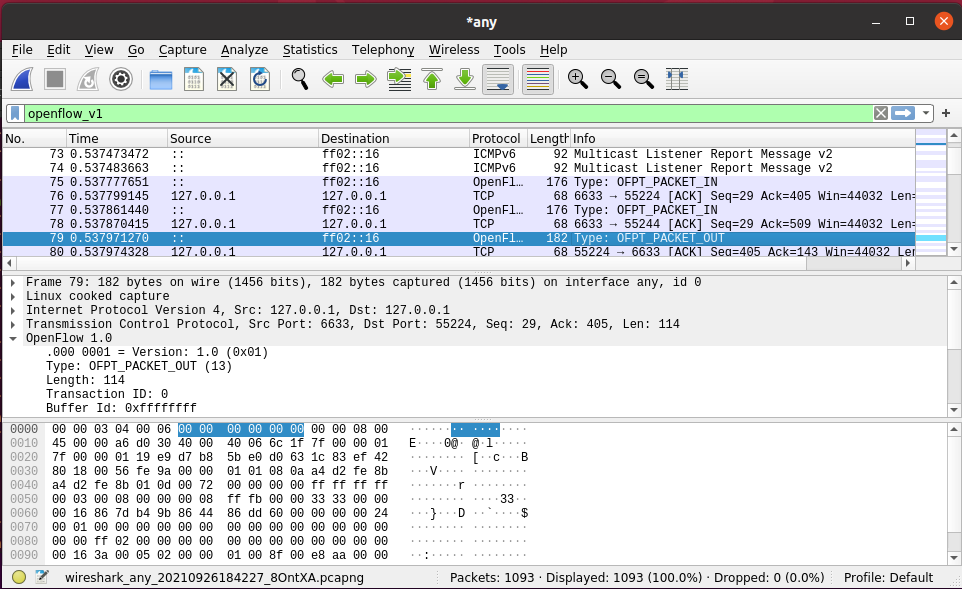
struct ofp_packet_out {
struct ofp_header header;
uint32_t buffer_id; /* ID assigned by datapath (-1 if none). */
uint16_t in_port; /* Packet's input port (OFPP_NONE if none). */
uint16_t actions_len; /* Size of action array in bytes. */
struct ofp_action_header actions[0]; /* Actions. */
/* uint8_t data[0]; */ /* Packet data. The length is inferred
from the length field in the header.
(Only meaningful if buffer_id == -1.) */
};
- FLOW_MOD

struct ofp_flow_mod {
struct ofp_header header;
struct ofp_match match; /* Fields to match */
uint64_t cookie; /* Opaque controller-issued identifier. */
/* Flow actions. */
uint16_t command; /* One of OFPFC_*. */
uint16_t idle_timeout; /* Idle time before discarding (seconds). */
uint16_t hard_timeout; /* Max time before discarding (seconds). */
uint16_t priority; /* Priority level of flow entry. */
uint32_t buffer_id; /* Buffered packet to apply to (or -1).
Not meaningful for OFPFC_DELETE*. */
uint16_t out_port; /* For OFPFC_DELETE* commands, require
matching entries to include this as an
output port. A value of OFPP_NONE
indicates no restriction. */
uint16_t flags; /* One of OFPFF_*. */
struct ofp_action_header actions[0]; /* The action length is inferred
from the length field in the
header. */
};
struct ofp_action_header {
uint16_t type; /* One of OFPAT_*. */
uint16_t len; /* Length of action, including this
header. This is the length of action,
including any padding to make it
64-bit aligned. */
uint8_t pad[4];
};
实验总结
(一) 出现的问题
- 抓不到hello包
解决方法:需要先打开wireshark抓包再运行python文件
- 通过过滤规则openflow_v1后找不到从交换机到控制器的hello包
解决方法:发现交换机版本为openflow1.5,选择过滤规则为openflow_v6或者不设置过滤规则,可以抓取到该hello包
(二)个人心得
本次实验我们通过抓取数据包、分析数据包学习了OpenFlow协议下控制器和交换机的交互过程。本次实验是验证性实验,难度不大,只要按部就班一步步做就好。通过抓包并查看每一个OpenFlow数据包的源端口、目的端口、类型和相关字段,我更进一步了解与掌握了OpenFlow协议。通过这次实验,我能够更加熟悉运用 wireshark 软件进行抓包,且让我对拓扑建立使用到的协议和数据交互流程有了更深的理解;更加熟悉了mininet的一些命令行操作;


